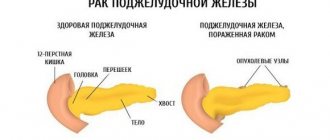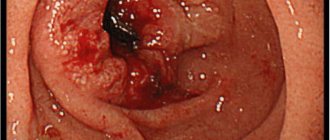Pancreatic adenocarcinoma is a malignant tumor, which, according to statistics, accounts for 80% of all types of neoplasms of this organ. By its name, it can be stated that it comes from glandular cells that are present in the mucous membrane and among the epithelium of the excretory ducts.
Experts divide all pancreatic cancers in relation to the endocrine apparatus into:
- exocrine (not associated with the production of hormones);
- endocrine (affecting hormonal balance).
Adenocarcinoma is part of the exocrine cancers. If we take into account the proportion of cases of this type of neoplasm in our group, then it accounts for 95%. The 2010 WHO clinical classification calls the tumor “ductal adenocarcinoma.” Most common among older men with chronic pancreatitis and alcohol dependence. In ICD-10 it is registered under code C25 in the class of malignant tumors.
What do the statistics say?
A study of morbidity shows that men get sick 1.5 times more often than women. The highest prevalence is observed among the population of the northern and eastern parts of the European continent (9 per 100 thousand men), in the USA and Japan - 7–9. Mortality rates for pancreatic adenocarcinoma do not differ from incidence rates. Among women in the same countries it is 3.8–6 per 100 thousand.
In Russia, based on the results of 2012, pancreatic cancer ranks 10th in men (3.2%) and in women thirteenth (2.7%) among malignant tumors.
A higher incidence has been established in the Maori group of peoples and among the aborigines of Australia, while the number of cases of disease among women is 10–15% more than among men
The study of cause and effect explains these features:
- low diagnostic capabilities in these areas;
- racial differences;
- such a specific factor as dietary habits.
The important role of environmental factors can be judged by the increase in the incidence of migrants who arrived from countries with a low prevalence of pathology in the troubled zone. After 10 years of living in a new place, people of the same age group show a clear increase in comparison with their historical homeland.
A racial feature is indicated by the fact that in the United States the prevalence of the disease among African Americans is 50% higher than among the white population.
Causes
There are various factors that contribute to the development of oncology; if we talk about pancreatic cancer, the reasons for its occurrence have not yet been established. Doctors identify several factors that can provoke cancer, including:
- Smoking, a bad habit, can have a detrimental effect not only on the functioning of the lungs, but also on other organs, including the lifespan;
- unfavorable living conditions, poor ecology in the region, high mortality from cancer, etc.;
- long-term diabetes mellitus, with lack of corrective therapy, medications;
- the patient has a history of chronic pancreatitis or liver disease;
- hereditary predisposition to the disease, the presence of deaths from cancer among relatives;
- obesity, metabolic disorders in the body, some genetic abnormalities.
Poor nutrition, bad habits and a sedentary lifestyle all aggravate the situation. However, as well as the presence of chronic diseases: inflammation of the pancreas, gastric ulcer.
Read: Pancreatic Cancer Treatment: Options Available Today
Recommended video:
Risk factors and probable causes of pathology
The causes of malignant lesions of the pancreas are still unknown, so scientists offer reliably identified risk factors studied on a large number of patients.
The greatest attention is paid to:
- Tobacco smoking - the risk is proportional to the “experience” and intensity. A cancerous tumor in the pancreas develops in 2% of smokers (in the lungs - in 10%). When smoking, the risk of developing cancer doubles; this cause dominates in every fourth patient.
- Nutritional characteristics - an opinion is expressed about an increased incidence of people who consume a lot of animal products, coffee and have a lack of plant fiber, vegetables, and fruits. However, it is not considered sufficiently substantiated.
- Obesity and type II diabetes mellitus are the most likely factors for the development of adenocarcinoma. The risk increases by 60% compared to people without diabetes and persists for at least 10 years. The most dangerous age is considered to be over 50.
- Chronic pancreatitis – increases the risk of adenocarcinoma by 20 times, regardless of the form of inflammation. Patients who have suffered from pancreatitis for more than five years are most susceptible. The occurrence of malignant growth is explained by the proliferation of epithelium in the ducts and acini of the gland with a simultaneous disruption of the process of restoring the structure of the organ.
- Hereditary pancreatitis occupies a special place; it increases the likelihood of malignant degeneration by 50 times. Although it occurs in 2% of patients. The cause is associated with mutations in the PRSS1 gene. In 40% of patients with a hereditary form of chronic pancreatitis, pancreatic adenocarcinoma develops. The addition of other listed factors significantly reduces the age of the sick. In pathogenesis, the main role is played by impaired inactivation of the trypsinogen enzyme, for which the altered gene is responsible. This leads to “self-digestion” of the acini cells.
- Infections – a connection has been established with previous viral hepatitis and Helicobacter. Microorganisms are important not only as a cause of stomach and liver cancer, but also in the pathology of the pancreas.
- Experts consider the carcinogenic effects of chemicals containing naphthylamine, benzidine, benzopyrene, asbestos, and acetylaminofluorene in industries associated with pesticides to be an important complicating factor.
Asbestos is widely used in the production of slate; builders are constantly in contact with it
Gastrectomy and cholecystectomy (removal of the stomach and gallbladder) operations have not yet been recognized as confirmed risk factors. But they continue to study.
Causes
Any malignant neoplasm is the result of a mutation of completely healthy cells, which, under certain conditions, begin to actively divide and form tumors. Medicine is not yet able to give an exact answer to the question: what exactly causes healthy normal cells to degenerate. Having observed many patients diagnosed with pancreatic adenocarcinoma, the main causes of the disease have been identified. They were of a recurring nature in various patients with this diagnosis.
- Smoking and alcohol. Bad habits destroy the pancreas and disrupt its normal functioning. Accumulated tobacco tars provoke malignant changes.
- Violation of the rules of nutrition (if the patient often eats fried foods, prefers snacks on the run, fast food) gives rise to digestive disorders, and this, in turn, destroys the pancreas.
- Genetic predisposition (mutation or reduction in the number of chromosomes in genes responsible for the prevention of malignant neoplasms). Our body is designed ideally by nature. He is able to regulate all processes occurring in him. But sometimes things can go wrong.
- Harmful environmental influences and work in hazardous industries. Living near chemical plants, cement plants, etc., or working at them contribute to disruption of the body’s self-regulation.
- The presence of diseases associated with the functioning of the pancreas: diabetes mellitus, pancreatitis. With such diseases, the gland no longer works correctly - it wears out. This is fertile ground for mutation of gland cells.
We also recommend viewing: What everyday foods are good and bad for the pancreas
How does heredity influence?
Having relatives with pancreatic adenocarcinoma in the family is considered a predisposing factor. The true familial form occurs in 5% of patients. And the degree of risk is taken into account near consanguinity:
- if one of the parents, brothers or sisters has adenocarcinoma, the risk increases by 2.3 times;
- with two closest patients - 6 times;
- with three - 32 times.
Ductal adenocarcinoma develops against the background of various genetic syndromes, does not have a common type of affected genetic mechanism, or it has not yet been established. Most often detected:
- with atypical nevus multiple melanoma;
- Peutz-Jeghers syndrome (growth of hamartomatous polyps in the stomach and intestines - growths from different types of tissue);
- hereditary chronic pancreatitis and familial adenocarcinoma.
Causes of the disease
Pancreatic adenoma can transform from a benign tumor into an adenocarcinoma if ignored for a long time.
Pancreatic adenocarcinoma occurs as a result of the following factors:
- Heredity. Genetic and chromosomal pathologies provoke the degeneration of gland cells. Therefore, children of parents who have been diagnosed with pancreatic malignancy are automatically at risk.
- Errors in diet. Eating foods enriched with preservatives, dyes, flavor enhancers and stabilizers provokes metabolic disorders.
- Malignant neoplasms localized in other parts of the gastrointestinal tract. Such tumors often metastasize, forming foci of malignancy in the pancreas.
- Exposure to radioactive radiation on the body. When its dose exceeds the limit level, cancerous tumors of various locations develop.
- Chronic pancreatitis. Persistent inflammation of the gland leads to cell degeneration.
- Diabetes mellitus type 1 and 2. This severe endocrinological disease affects the acini, leading to insulin deficiency. Autoimmune mechanisms can trigger a malignant process. Adenocarcinoma itself is an exocrine cancer not associated with hormone synthesis.
Characteristics of ductal adenocarcinoma
Normal pancreatic ducts are lined with cuboidal and low columnar epithelium. In cells:
- the nucleus is located in the basal zone;
- no crowding;
- mucin is not produced;
- typical mitotic division is rarely observed;
- there is no enhanced color characteristic and enlarged nuclei.
5% of the prevalence accounts for 7 mixed forms of ductal cancer. Experts point out that it is incorrect to judge the effectiveness of treatment when summing up the results with an adenocarcinomatous tumor, since mixed types of tumors are less aggressive, more common in women and have a better prognosis.
Ductal adenocarcinoma of the pancreas occurs in different parts of the organ:
- in the head with a frequency of 75%;
- in the body - 18% of cases;
- in the tail - in 7% of patients.
In some patients, it is not possible to accurately determine the initial location of the tumor.
The secretions produced in the acini enter the ducts of the exocrine pancreas.
Varieties
Depending on the pathological changes in the gland cell, there are 3 degrees of differentiation of pancreatic cancer:
- Poorly differentiated type of neoplasm.
- Highly differentiated.
- Moderately differentiated.
A highly differentiated degree is a minor change in which the disease develops slowly; there are conditions and possibilities for treatment.
Important. Poorly differentiated tumors are characterized by a higher rate of division and the tumor progresses quickly. Treatment is difficult.
At a moderately differentiated stage, treatment is impossible and will not bring results. Cells divide at a tremendous speed, and there is a risk of developing complications. Metastases spread to neighboring organs.
We also recommend viewing: Collection for the pancreas: features of proper treatment
The most common type is ductal adenocarcinoma of the pancreas. It develops when the cells of the main pancreatic duct, which produce juice and enzymes involved in digestion, are damaged. It develops faster than other types and metastasizes at high speed. Accompanied by very severe pain. There is virtually no hope for treatment.
Histological characteristics
Ductal adenocarcinoma consists of glandular cells that mimic normal structures. They grow inside the parenchyma of the organ. According to the degree of differences there are:
- A highly differentiated tumor - forms pathological glandular structures, the ducts change and take on an irregular shape, the direction is chaotic. This type of tumor is called “large ductal.” Tumor cells are represented by single-layer epithelium of cuboidal or cylindrical type, with light cytoplasm. The cell nuclei are round in shape, slightly enlarged, the stage of mitosis is rarely detected. In the interlobular ducts, normal epithelium is replaced by columnar epithelium. Tumor cells are found in blood vessels, the common bile duct, the papilla of Vater and the body of the duodenum.
- Moderately differentiated type - characterized by the presence of many small tubular glands with ducts. The nuclei in tumor cells have different sizes, and the number of mitoses is increased. At the borders of the tumor, defective glandular structures are revealed.
- Poorly differentiated type - contains numerous defective small glands, there are entire layers and foci of cells with nuclei of various shapes, there is no mucin synthesis, the distribution is often perineural or through the vessels.
Low differentiation is characterized by rapid metastasis:
- to the liver;
- peritoneum;
- duodenum;
- lymph nodes;
- stomach;
- spleen;
- gallbladder.
It can completely block the ducts, which causes atrophy of both exocrine and endocrine structures. Therefore, imitation of a neuroendocrine tumor often occurs.
Pain therapy
Symptomatic treatment is based on the use of analgesics. This is due to the fact that in the later stages of pancreatic cancer, severe pain comes to the fore.
At the initial stage of cancer tumor development, you can cope with unpleasant sensations with the help of nonspecific anti-inflammatory drugs: Paracetamol, Ibuprofen, Naproxen and other drugs. You need to take medications 1-2 tablets once a day, with increased pain - up to 2-3 tablets. per day.
If there is no positive result from the use of such anti-inflammatory drugs, the doctor may decide on the need to include weak opiates in the therapeutic regimen. These are Tramadol, Dihydrocodene and Promedol, which are available in several dosage forms: tablets and injection solutions, etc. One of the main side effects of these drugs is a high risk of addiction, as a result of which, for pain relief, you need to take or inject an increasingly larger dose each time .
At the terminal stage of the disease, when the pain is so severe that a person cannot sit, lie or even sleep, the use of powerful opiates (Prosidol, Fentanyl) is indicated. They are mainly used in hospitals as palliative therapy. In some cases, when the patient is at home, injections are given by a special medical worker, since these drugs are part of a group of narcotic drugs that are under strict control.
How is the tumor stage determined?
Pancreatic adenocarcinoma is classified according to international standards according to tumor size, invasion of lymph nodes and the presence of metastases. For example, depending on location and size, they distinguish:
- Tx – a situation where there is insufficient data to assess tumor growth;
- T (stage zero) – initial stage or “precancer”;
- T1 – the tumor borders do not extend beyond the pancreas, and the maximum size is no more than 2 cm in diameter;
- T2 – like T1, but larger than 2 cm;
- T3 – the boundaries extend beyond the organ, but the celiac trunk and superior mesenteric artery are not yet involved;
- T4 (stage 4) – growth spreads to the celiac trunk or to the area of the superior mesenteric artery.
According to modern classification, these stages should be called T1 and T2
Main symptoms
Pancreatic adenocarcinoma is dangerous because in the initial stages it shows almost no symptoms. A person often feels as usual and does not see a doctor. Only as the tumor develops further does suspicion arise regarding its presence. With different localization of the tumor, the symptoms will vary slightly. The first signs will be:
- loss of appetite and aversion to food;
- weight loss;
- fatigue, severe weakness;
- chronic state of depression.
When adenocarcinoma of the head of the pancreas forms, the following signs are added to the general symptoms:
- aching pain in the intestines and stomach;
- feeling of heaviness;
- yellowing of the skin;
- constant feeling of thirst;
- temperature increase.
As pancreatic adenocarcinoma grows, it can be easily felt. At the same time, many nearby organs increase in size. Stage 4 pancreatic adenocarcinoma becomes incurable. At the very last stage, with rapid metastasis, more and more new signs of the disease appear, which largely depend on which organ is affected. If metastases reach the liver from pancreatic adenocarcinoma, signs of liver failure appear. And if it goes into the intestines, an obstruction will develop and there will be internal bleeding.
At this stage, anemia and anorexia also develop. One of the reasons for sudden weight loss is considered to be metabolic disorders, as well as weak immunity. Thrombosis and thrombophlebitis are characteristic.
Where does the tumor metastasize?
Oncologists note a higher frequency of separated metastases when the cancer is located in the body or tail of the pancreas. What matters here is the increasing duration of the disease. The share of each localization in the total number of cases was determined:
- most often it is the liver (from 53 to 60%);
- lungs and peritoneum (10–12 and 11–16%, respectively);
- bones – up to 7%;
- adrenal glands and kidneys – 5–6%;
- pleura – 4–10%;
- small intestine – 3%;
- diaphragm and spleen – 2% each;
- pericardium, myocardium, brain - 1% each.
- 5% falls on other organs.
Data on the frequency and location of metastases were obtained from pathological studies of deceased patients
Structure of pancreatic cancer and prognosis
The duration of cancer in the tissues of the pancreas largely depends not only on the stage of the disease - four or less, but also on the structure of the tumor. So, experts identify several main forms:
- adenocarcinoma is recognized as the most aggressive and unfavorable in its course – it accounts for 80–90% of the total volume of all identified cancers
- squamous cell form - cancer cells form in the glandular epithelium covering the excretory ducts of the gland;
- acinar form - cancer is formed from the internal cells of an organ or the epithelium of its ducts, and has a less aggressive course;
- rare forms - somatostatinoma, a tumor that produces large amounts of somatostin, a hormone that can inhibit the production of enzymes by the organ.
Of course, aggressive and rapidly metastasizing forms - adenocarcinoma, cystadenocarcinoma, at the 4th stage of their development will be characterized by a rapid expansion of the area of the cancerous lesion, an increase in the general intoxication of the patient's body. Each of them does not have a favorable outcome in prognostic terms.
The situation is aggravated by the appearance of secondary foci - metastases with a similar or different tumor structure. Each such focus of cancer has its own negative impact on the patient’s well-being.
Symptoms
The clinical manifestation of pancreatic adenocarcinoma is determined by localization, intensity, and stage of growth. If the size is small, the patient does not feel symptoms. When the node grows, it compresses the ducts, impairing the outflow of bile and pancreatic secretions.
Patients experience:
- attacks of nausea;
- belching of undigested food;
- diarrhea;
- loss of appetite;
- intense pain in the epigastric region, radiating to the back, they are described as “girdling”;
- yellowness of the skin and sclera;
- loss of body weight;
- skin itching;
- there is an admixture of blood in the stool, its color becomes lighter than usual;
- the urine becomes dark and there may be signs of bleeding.
When palpating the patient's abdomen, the following is found:
- local soreness in the upper part;
- enlarged, tense gallbladder (in thin patients);
- enlarged spleen.
At later stages, elevated temperature and signs of anemia (weakness, headache, dizziness, rapid heartbeat) are observed.
Pain syndrome is associated with:
- with tumor damage to nerve trunks;
- development of local edema;
- increased pressure in the pancreatic and bile ducts with their expansion and overflow;
- germination of perineural carcinous cells;
- trophic disorders of the organ;
- spread to the retroperitoneal nerve plexuses;
- signs of inflammation in the gland parenchyma and bile ducts;
- spasm of all smooth muscle structures (arteries);
- damage to neighboring organs.
Functional disorders in the form of belching, vomiting, bloating are explained by:
- spasm of the smooth muscles of large ducts and vascular walls;
- trophic disorder of the pancreas and surrounding organs;
- impaired neuroendocrine regulation of the secretory and motor functions of the gallbladder, stomach, intestines (therefore diarrhea, constipation, and steatorrhea in stool tests).
Nausea and vomiting may be due to impaired gastric emptying or compression of the small intestine.
Fever most often indicates:
- for infection in the bile ducts and bladder;
- inflammation of the pancreatic parenchyma;
- tumor disintegration;
- suppuration of cysts, internal fistulas.
Hyperthermia is one of the signs of pathology progression
A feature of the clinical course of adenocarcinoma is the nonspecificity of symptoms. None of the given signs are characteristic only of this disease and do not indicate the location of the tumor.
Signs
How is it that many people do not pay attention to the initial symptoms of pancreatic cancer? This is simply to blame for the weak symptoms of oncology at stages 1 and 2 of its development. Minor manifestations are interpreted by people as malnutrition or minor poisoning.
Often added to this is a passive attitude towards life, alcohol, smoking, which causes discomfort in the sternum and abdomen. Only with the development of the third stage do vivid symptoms begin to appear and the means used for self-medication no longer bring relief from the pain condition, but only deterioration.
Pancreatic cancer, stage 4, has its own characteristics and a strong pattern of progression. In this case, there are diseases of the digestive system and various pathologies of already affected neighboring organs that are affected by metastases of the cancer. Metastases at this level of development affect:
- primarily affects neighboring human organs (intestines, spleen, duodenum, stomach);
- Through the bloodstream, infected cells enter the lungs, liver, and brain of a person.
metastases in the intestine
Much depends on the site of onset of the oncological pathology. Let’s say that when the body of the pancreas is damaged, the main type of damage occurs in the liver. The resulting metastasis in the liver affects the entire tissue of the organ, which worsens the patient’s condition. In this case, an important factor in the damage is the close location of the liver to the pancreas.
At the same time, the liver transmits infection to the bile ducts, which provokes the occurrence of mechanical hepatitis. This is already becoming the last sign of the development of stage 4 pancreatic cancer.
There is also a strong enlargement of the lymph nodes on the human body. Their signs and symptoms become:
- painful;
- loose and easy to palpate.
And also the pathology spreads to the intestines, since, again, it is in direct contact with the affected pancreas, and this creates an obstruction in the organ.
Previously diagnosed pancreatitis creates certain difficulties, so a person does not see the symptoms of pancreatic cancer, but in stage 4 they are:
- severe attacks of nausea and vomiting;
- the pain increases when lying down;
- skin color changes to yellow;
- severe fatigue with minor exertion;
- constant drowsiness;
- significant weight loss in a matter of days;
- lack of appetite.
yellowness of the skin
At stage 4 of cancer, the development of a malignant formation of the pancreas reaches its apogee of development and strong symptoms that do not calm down and continue to remind themselves with increasing pain. The appearance of a tumor at the 4th stage of pancreatic cancer creates a complete malfunction of the human digestive system. Stagnation occurs in the intestines, the choleretic ducts become clogged, and the entire gastrointestinal tract system becomes unusable. Dysfunction of the pancreas stops producing the necessary enzymes, which leads to acute pancreatitis based on oncological pathology and necrosis of tissues and organs. This condition worsens overall health and accelerates the process of complete destruction of the body.
Diagnostic methods
The disease can last for a long time under the diagnosis of chronic pancreatitis. It is very difficult to detect the initial stage. The following methods are used:
- general blood and urine analysis - indigestion leads to mixed type anemia (B12-deficiency + iron deficiency), if an infection is added to the blood, leukocytosis appears with a shift of the formula to the left;
- study of biochemical blood tests for the content of residual nitrogen, protein fractions, glucose, bilirubin, enzymes (alkaline phosphatase, amylase and transaminase);
- tumor markers and antigens DuPan, CA19-9, TAG72, Spanl, CA125;
- ultrasonography;
- the patency of the ducts of the gallbladder and pancreas is checked endoscopically (retrograde cholangopancreatography);
- X-ray duodenoscopy is performed using a contrast agent;
- computed tomography is also best used with contrast;
- histological examination and biopsy.
Necessary tests and examinations
When talking with a doctor, the patient should first of all be questioned about complaints and symptoms. The initial examination includes palpation of the abdominal area, including the pancreas area.
Tests and examinations for suspected cancer must be comprehensive. A biochemical blood test should illustrate the level of bilirubin, enzymes, bile acids, and liver transaminases. These rates increase with this type of cancer. The level of proteins, on the contrary, decreases.
The location of the tumor focus can be seen by ultrasound and X-ray methods, such as magnetic resonance and computed tomography, cholangiography, angiography. With these studies, you can see the size of the tumor and the extent of organ damage.
The malignant nature of the tumor is confirmed by a biopsy. With its help, the type of cancer is also identified. Therefore, histological analysis is mandatory for final confirmation of the diagnosis.
Treatment
The basis of treatment is surgical removal. Malignant pancreatic cells do not respond to cytotoxic drugs.
Complete removal of the gland (pancreatectomy) is rarely performed, because its consequence is necessarily a severe form of diabetes mellitus.
For adenocarcinoma in the head region, a classic pancreaticoduodenectomy is performed. The operation involves complete excision of:
- gland heads;
- parts of the duodenum;
- gallbladder;
- if necessary, resection of the stomach and common bile duct.
Anastomoses are formed between the remaining organs to ensure digestion. The operation is considered difficult, accompanied by a 15% mortality rate. Not all oncologists consider it justified, since survival over the next few years is ensured only for every tenth operated patient. Surgical methods are much more often used to eliminate obstruction of the ducts and obstructive jaundice.
A combination of chemotherapy with Gemzar and radiation is used as a temporary relief measure (palliative method). It is possible to stop the growth of the tumor. The following are recommended as painkillers:
- No-shpa;
- Spazgan;
- Ketorolac.
The drugs are prescribed by injection, since patients have impaired absorption and often vomit
Maintenance therapy includes the administration of enzymatic drugs to compensate for the lack of pancreatic juice. These include:
- Creon;
- Pancreatin;
- Pancitrate;
- Penzital;
- Panzinorm;
- Enzistal.
Stage 4 pancreatic cancer: features of the disease
If the cancer grows and extends beyond the pancreas, and the cancer cells disperse into separate organs and lymph nodes, then the doctor diagnoses pancreatic cancer in the fourth stage.
Complete recovery is impossible for several reasons : the pancreas and organs affected by the disease cease to function.
Drugs and surgical treatments are unable to fully utilize all methods to remove tumors and cancer cells, which does not allow complete elimination of the disease in the pancreas.
The main problem of this cancer is that in the early stages the disease makes itself felt with weak manifestations and is quite difficult to recognize.
Pancreatic cancer, like other types of oncology, has certain stages.
The stages of cancer include:
- At stage zero, there are no symptoms in the body. However, cancer is already beginning to develop in the human body. It is impossible to do without surgery on the pancreas.
- First stage . Cancer is already visible using diagnostic methods. The size of the tumor is 2 cm. The operation can be performed successfully, and then the doctor creates a certain diet to prevent further manifestations of the disease in the pancreas.
- Second stage . The tumor is already clearly visualized and affects the lymph nodes, but there are no metastases. The doctor prescribes a course of chemotherapy and surgery, during which part of the organ is cut out, or it is completely removed. According to statistics, about 30 percent of people can live more than 10 years with cancer if they correctly follow the instructions of their treating specialist.
- Third stage . It is characterized by the fact that the tumor reaches such a size that it can affect nerves and blood vessels. Metastasis is not observed at this stage of cancer. After surgery, a person may develop other diseases. Therefore, every fifth patient needs a new operation within a year after the previous treatment. Treatment is carried out to relieve pain and prolong the patient’s life.
- In the fourth stage of cancer, a person experiences pain in the pancreas area. Metastases are already present in the body; surgery is not always indicated if this stage of the disease is diagnosed. Typically, treatment is based on maintaining normal health and prescribing a certain diet that can prolong life by several months or years.
The size of the resulting tumor often reaches five and sometimes six centimeters. They don't live with her for long. According to statistics, even 4% of patients cannot live more than five years.
Another article on this topic: Creon: instructions for use, reviews, analogues
Forecast
The prognosis of the disease is unfavorable. While there is no clear method for early diagnosis, there is no way to stop growth and metastasis. Therefore, the practice of oncologists shows disappointing results:
- the life expectancy of patients from the moment signs of adenocarcinoma appear is no more than 1.5 years;
- only 2% survive 5 years;
- Repeated operations enable patients to live for 4–5 years.
The main attention should be paid to the prevention of risk factors and monitoring of patients with family problems in oncology. We can only hope for the invention of new treatment methods.
Causes and symptoms of the disease
Pancreatic cancer refers to a phenomenon in which the DNA in the organ stops behaving normally and cancer cells gradually multiply.
People who have problems with the following diseases are most likely to get cancer::
- cysts in the pancreas;
- benign tumors;
- presence of diabetes mellitus;
- pancreatitis.
Attention! One of the main causes of the disease is considered to be: smoking and excessive consumption of alcoholic beverages. These bad habits increase your chance of getting sick.
Another probable cause of cancer is working in an enterprise where there is contact with asbestos or other chemicals.
Previously undergone operations to eliminate pathologies of the gastrointestinal tract also leave an imprint on the health of the pancreas, causing cancer.
Predisposing factors for cancer include: unbalanced diet, sedentary lifestyle and excess weight.
At stage 4 of pancreatic cancer, the patient experiences severe pain in the area where the organ is located. In addition to pain, there are a number of manifestations and symptoms that indicate pancreatic cancer:
- nausea;
- temperature;
- constipation and diarrhea;
- presence of vomiting;
- changes in urine and feces;
- if the tumor has affected the bile ducts, then manifestations of jaundice.
Additional symptoms of cancer include sudden weight loss as digestive processes are disrupted. The patient experiences problems with appetite, stomach and itchy skin. In addition to these cancer symptoms, excessive nervousness may be present.
Men, according to statistics, suffer from this disease more often than women. This disease most often affects people over the age of sixty. Therefore, you need to monitor your health in old age.
Diabetes mellitus and problems with intestinal functionality may be associated with the disease. This pathology is especially acute if there is intestinal obstruction, for which immediate hospitalization is indicated.
| Stage | Percentage of probability of an accurate diagnosis | Possibility to live for 5 years |
| 1 | 0.07 | About 20 % |
| 2-3 | 0.26 | Approximately 8.2% |
| 4 | 0.52 | 0.018 |
| Relapse | — | No more than 1 percent |










